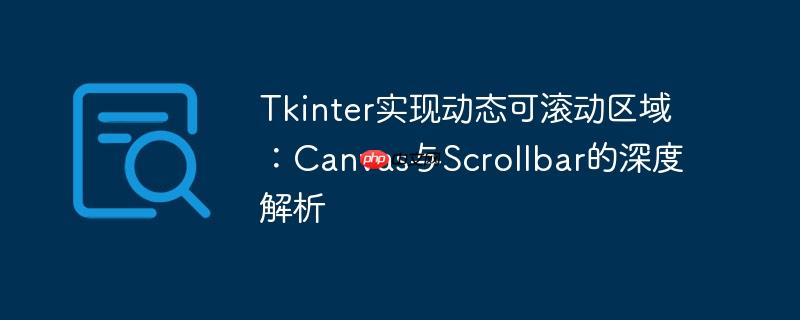
在开发图形用户界面(gui)时,我们经常会遇到内容长度不确定或超出窗口显示范围的情况。例如,一个用户配置文件编辑器可能需要添加任意数量的“检查项”,这些检查项应该在一个固定大小的区域内显示,并通过滚动条进行导航,而不是无限扩展窗口大小。tkinter提供了canvas和scrollbar组件来解决这一问题,但其实现方式对于初学者而言常有困惑,尤其是在与grid布局管理器结合使用时。
常见的挑战包括:
实现一个可滚动的区域,通常需要以下三个核心组件协同工作:
在构建可滚动区域时,开发者常遇到以下几个问题:
当一个Frame被设置为grid_propagate(False)时,它将不再根据其内部组件的大小自动调整自身大小。这意味着你必须显式地为该Frame设置一个固定的宽度和高度。如果这个Frame是Canvas的父容器,并且你没有给它设置足够大的尺寸,那么Canvas可能无法显示,或者显示区域过小。
问题示例:
checkFrame = Frame(titleFrame) checkFrame.grid(row=2,column=0,padx=5,pady=5, sticky='nw') checkFrame.grid_propagate(False) # 导致问题
这里checkFrame是scrollCanvas和gScrollbar的父容器。如果checkFrame被propagate(False)且没有显式设置大小,它将默认为1x1像素,导致内部的Canvas和Scrollbar无法正常显示。
解决方案:
这是最常见的错误之一。当内容Frame已经通过Canvas的create_window()方法放置到Canvas内部后,不应该再对这个内容Frame调用grid()、pack()或place()等布局管理器方法。一个组件不能同时被两种不同的布局机制管理。
问题示例:
# Create frame to contain checks gChecksFrame = Frame(scrollCanvas, bg='blue') scrollCanvas.create_window((0,0),window=gChecksFrame, anchor='nw') gChecksFrame.grid(row=1,column=1,padx=10,pady=5) # 错误!gChecksFrame已被create_window管理
gChecksFrame已经被create_window放置在scrollCanvas的(0,0)位置。后续的gChecksFrame.grid(...)会引发冲突,可能导致组件消失或布局混乱。
解决方案:
Canvas需要知道其内部所有内容的总尺寸,才能正确计算滚动条的范围。这个总尺寸由scrollregion属性定义。如果内容Frame的大小发生变化(例如,动态添加了新的控件),但Canvas的scrollregion没有更新,那么滚动条将不会出现或无法正确滚动。
问题示例: 原始代码中没有机制来更新scrollCanvas的scrollregion。
解决方案:
# 关键:当gChecksFrame大小改变时,更新Canvas的scrollregion
gChecksFrame.bind("<Configure>", lambda e: scrollCanvas.config(scrollregion=scrollCanvas.bbox("all")))下面将展示一个修正后的Tkinter程序,它能够创建一个可滚动的区域,并动态添加检查项。
首先,我们设置主窗口、配置文件名区域和标题区域。
import tkinter as tk
gCheckList = []
tCheckList = []
def addCheck(check_type, parent_frame):
"""
Adds a new check row to the profile editor.
parent_frame should be the gChecksFrame (inside the canvas).
"""
checkFrame = tk.Frame(parent_frame, bd=1, relief="solid") # Added border for visibility
# Determine the row based on the list length for dynamic placement
if check_type == 'g':
list_length = len(gCheckList)
gCheckList.append(checkFrame)
elif check_type == 't':
list_length = len(tCheckList)
tCheckList.append(checkFrame)
else:
return
checkFrame.grid(row=list_length, column=0, padx=5, pady=2, sticky='ew')
checkName = tk.Text(checkFrame, width=15, height=1, font=('Courier', 10))
checkName.grid(row=0, column=0, padx=5, pady=2)
checkName.insert(tk.END, f"Check {list_length + 1}") # Example content
# Add more widgets if needed, e.g., Indicator, 1-14 values
# For simplicity, just adding a label here
indicator_label = tk.Label(checkFrame, text="Indicator", font=('Courier', 10))
indicator_label.grid(row=0, column=1, padx=5, pady=2)
# Force parent_frame (gChecksFrame) to update its geometry,
# which will trigger the <Configure> event and update scrollregion.
parent_frame.update_idletasks()
# Creates root window
root = tk.Tk()
root.title('Profile Editor')
# root.geometry('750x300+250+225') # Removed to allow window to size dynamically
# Creates profile name frame
profileNameFrame = tk.Frame(root)
profileNameFrame.grid(row=0, column=0, padx=10, pady=5, sticky='ew')
# Creates a spot to name the profile
nameLabel = tk.Label(profileNameFrame, text='Profile Name: ', font=('Courier', 12))
nameLabel.grid(row=0, column=0, padx=10, pady=5)
nameText = tk.Text(profileNameFrame, width=30, height=1, font=('Courier', 12))
nameText.grid(row=0, column=1, padx=10, pady=5)
# Frame for title and headers
titleFrame = tk.Frame(root)
titleFrame.grid(row=1, column=0, padx=10, pady=5, sticky='ew')
titleFrame.grid_columnconfigure(0, weight=1) # Allow content column to expand
gCheckProfileLabel = tk.Label(titleFrame, text='Header for Checks', font=('Courier', 14))
gCheckProfileLabel.grid(row=0, column=0, padx=10, pady=5, sticky='w')
# Frame for headers (e.g., Check Name, Indicator, 1-14)
headerFrame = tk.Frame(titleFrame)
headerFrame.grid(row=1, column=0, padx=10, pady=5, sticky='ew')
headerLabel = tk.Label(headerFrame, text='Check Name Indicator ' + ''.join([f'{i:2} ' for i in range(1, 15)]), font=('Courier', 10))
headerLabel.grid(row=0, column=0, sticky='ew')
# --- Scrollable Area Implementation ---
# 1. Parent frame for Canvas and Scrollbar
# This frame will manage the size of the scrollable area.
scrollable_area_frame = tk.Frame(titleFrame, bd=2, relief="groove", height=200) # Fixed height for scrollable area
scrollable_area_frame.grid(row=2, column=0, padx=5, pady=5, sticky='nsew')
scrollable_area_frame.grid_rowconfigure(0, weight=1)
scrollable_area_frame.grid_columnconfigure(0, weight=1)
# No grid_propagate(False) here unless we explicitly set width/height for scrollable_area_frame
# If we want scrollable_area_frame to have a fixed height, we set it directly.
# 2. Canvas for scrolling
scrollCanvas = tk.Canvas(scrollable_area_frame, bg='lightgray')
scrollCanvas.grid(row=0, column=0, sticky='nsew')
# 3. Scrollbar linked to Canvas
gScrollbar = tk.Scrollbar(scrollable_area_frame, orient='vertical', command=scrollCanvas.yview)
gScrollbar.grid(row=0, column=1, sticky='ns')
scrollCanvas.configure(yscrollcommand=gScrollbar.set)
# 4. Content Frame inside Canvas
# This frame will hold all the dynamically added check rows.
gChecksFrame = tk.Frame(scrollCanvas, bg='white')
# Use create_window to place gChecksFrame inside the canvas
scrollCanvas.create_window((0, 0), window=gChecksFrame, anchor='nw')
# 5. Crucial: Bind <Configure> event to gChecksFrame to update Canvas scrollregion
gChecksFrame.bind("<Configure>", lambda e: scrollCanvas.config(scrollregion=scrollCanvas.bbox("all")))
# Creates a new check row to be added into the program
addGCheckButton = tk.Button(titleFrame, text='+', font=('Courier', 14), command=lambda: addCheck('g', gChecksFrame))
addGCheckButton.grid(row=0, column=1, padx=1, pady=5, sticky='e') # Placed next to header label
root.mainloop()通过本教程,我们深入理解了在Tkinter中创建动态可滚动区域的关键技术。核心在于:
掌握这些原则,你将能够灵活地构建出具有动态、可滚动内容的Tkinter应用程序,极大地提升用户体验。
以上就是Tkinter实现动态可滚动区域:Canvas与Scrollbar的深度解析的详细内容,更多请关注php中文网其它相关文章!

每个人都需要一台速度更快、更稳定的 PC。随着时间的推移,垃圾文件、旧注册表数据和不必要的后台进程会占用资源并降低性能。幸运的是,许多工具可以让 Windows 保持平稳运行。

Copyright 2014-2025 https://www.php.cn/ All Rights Reserved | php.cn | 湘ICP备2023035733号